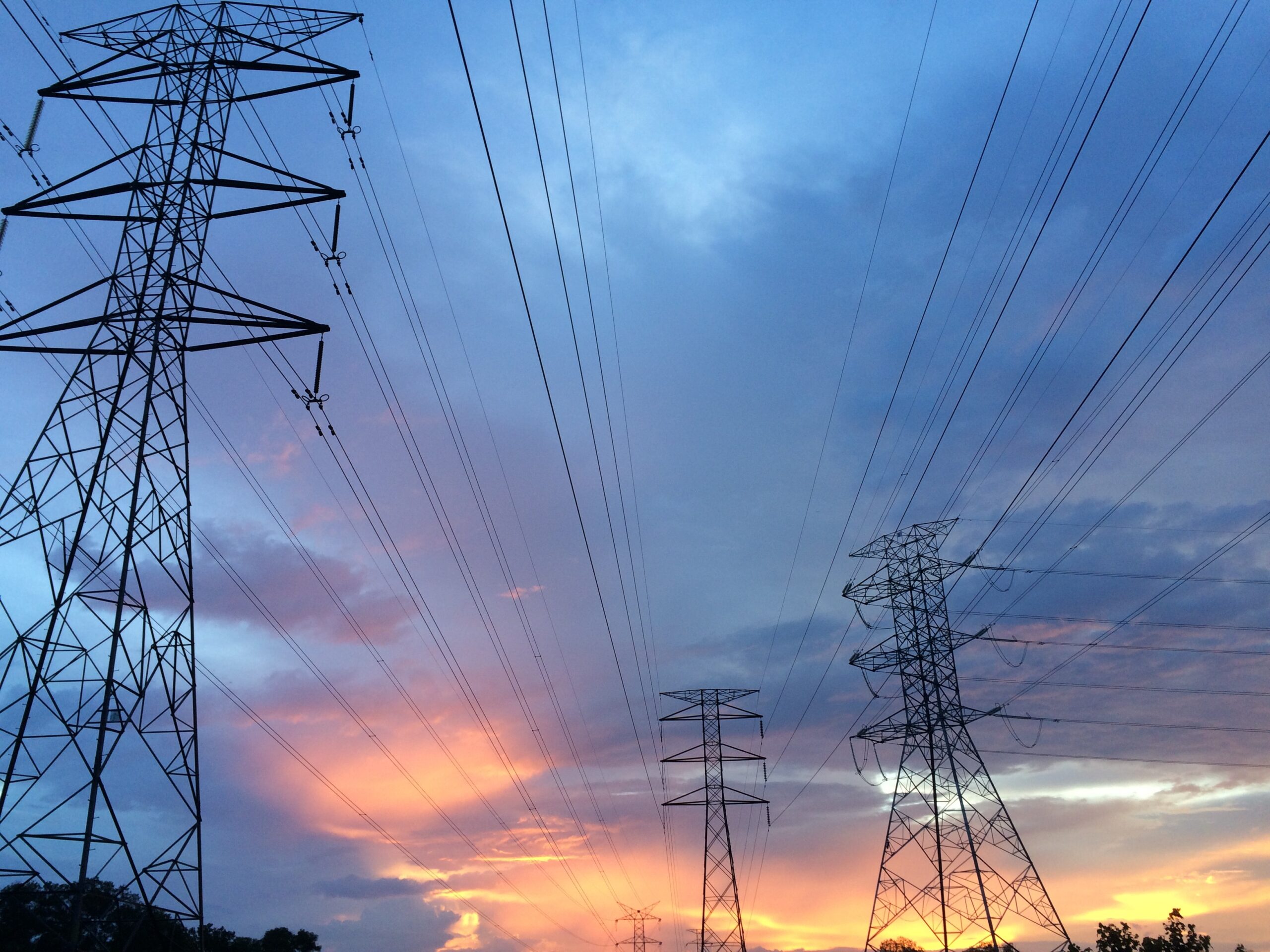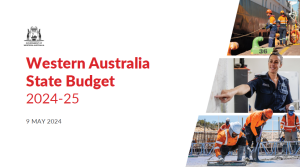Submission to the Economic Regulation Authority on Western Power’s access arrangement proposal for the period 2022/23 to 2026/27 (AA5).
Introduction
For the average household in the South West Interconnected System (SWIS), network costs comprise around 45 per cent for their total electricity bill.1 As a result, networks costs and the decisions made in access arrangement reviews have a significant impact on the affordability of electricity for consumers.
A person’s economic position and life circumstances should not exclude them from affordable access to an essential service like electricity. WACOSS considers that it is critical for the Economic Regulation Authority to consider, as part of its decision making process, the impacts that the various components of Western Power’s access arrangement will have on consumers who are on low incomes or are experiencing other forms of hardship, marginalisation and vulnerability.
Recommendations
The following recommendations for the consideration of the Economic Regulation Authority in its deliberations on Western Power’s access arrangement proposal are informed by the subsequent analysis continued within this submission.
- Reductions in revenue should result from network efficiencies to ensure the long term affordability of electricity.
- Continued growth in the Regulated Asset Base needs to be closely scrutinised and avoided where possible, with asset write-downs considered
- Maintain the ERA’s current approaches to calculating the cost of debt and the term of the risk free rate.
- Service standards should not exceed consumers’ willingness to pay for service quality
- The fixed charge component of the reference tariffs should not be increased.
- Analysis is required as to the potential impacts of the new super-off peak time of use tariffs on different household types.
- Two-way pricing options should be considered for households with solar PV to ensure greater affordability and fairness, while enabling higher levels of DER integration.
- Clarity is needed as to the proposed future of the RT1
- A smoother price path over the AA5 period should be applied.
Low income households and electricity usage
Low income households are not homogenous and use electricity for different purposes and in different ways. Households who are part of an electricity retailer’s hardship program are likely to have particularly high energy usage patterns, while others seek to manage their living costs by under-consuming electricity, which can be to the detriment of their health and wellbeing.2
While not all households and experiences are the same, what the data indicates, however, is that low income households are overrepresented amongst low-energy users.3
Expenditure by equivalised disposable household income ($ per week)
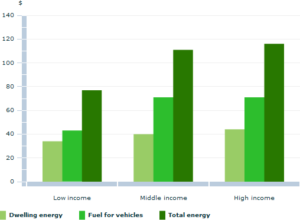
Source: ABS (2013) 4670.0
Despite this, what is also clear is that the cost of energy disproportionately impacts households on the lowest incomes, as they spend a significantly higher percentage of their disposable income on energy bills and have little, if any, capacity to absorb additional costs.
Electricity & gas expenditure as a percentage share of income by disposable income quintiles (Australia-wide)
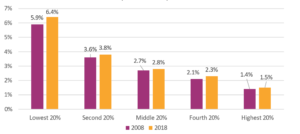
Source: ACOSS and the Brotherhood of St Laurence (2018)
People on the lowest incomes spend on average 6.4 per cent of their income on energy, compared to households in the highest income quintile, who pay on average only 1.5 per cent. When each income quintile is examined more closely, as in the graph below, it can be seen that 25 per cent of the lowest income quintile are spending over 8.8 per cent of their income on energy. 4
Percentile distribution for electricity and gas expenditure as a percentage of income by disposable income quintiles
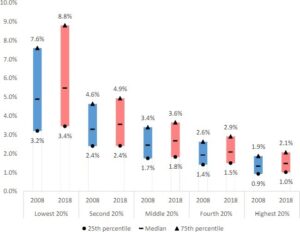
Source: ACOSS and the Brotherhood of St Laurence (2018)
While a growing number of Western Australian households have invested in small-scale DER like home solar PV, the ability and capacity to do so is not equally shared. For households on low incomes and those living in rental housing, it is not possible to install solar PV and gain the benefits that such technology provides.
RAB closing balance, $M
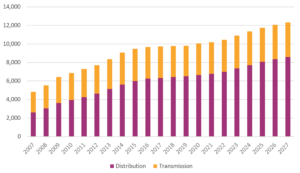
Source: Western Power’s AA5 Regulatory Revenue Model
The inequity in access to DER further exacerbates the impact that electricity prices and their structures have on low income households. The disproportionate impact of electricity bills on low income households can lead to mounting unpaid bills and resulting disconnections, which in turn can have a significant impact on people’s wellbeing. Impacts include feelings of shame, the stress of trying to stretch your income as far as possible, and the difficult decisions they have to make around what to prioritise.
Disconnections can have a range of detrimental impacts for households already struggling with everyday living costs, including loss of food, an inability to bathe or to heat or cool rooms, or to maintain connection with relatives and the wider world, leading to health problems, anxiety and emotional disorders. These debts can also affect their ability to access affordable credit in future.
Over late 2018 and early 2019, the 100 Families WA collaborative research project conducted a baseline longitudinal survey with 400 families living in Perth, as part of developing an ongoing evidence base on poverty and social exclusion in Western Australia. The findings of the survey reveal the significant challenges and level of hardship being experienced by these Western Australian families. More than two-thirds of the 100 Families WA Project family members (67.8 per cent) reported that they could not pay their utility bills on time on at least one occasion during the year, while 23.3 per cent had been unable to heat their homes. 15 per cent they could not afford to keep at least one room of their house adequately warm when it is cold. 6
Long term affordability
WACOSS notes that the lower target revenue proposed to be recovered over the AA5 period compared to the AA4, is principally only lower due to the current cost of capital, and not due to network efficiencies or reform. Without any efficiency improvements in capital expenditure or operational expenditure, the long term affordability of electricity is at considerable risk from external factors, including when the cost of capital increases, which will increase the network’s rate of return on capital.
Recommendation: Reductions in revenue should result from network efficiencies to ensure the long term affordability of electricity.
Instead, Western Power is proposing to grow the Regulated Asset Base (RAB) and has put forward a number of step change increases in its operational expenditure. As the RAB grows further, higher costs for consumers are guaranteed over the long term as they continue to pay for these assets through depreciation.
RAB Closing Balance, $M

Source: Western Power’s AA5 Regulatory Revenue Model
In the interests of the long term affordability of electricity, it is critical that the increases in capex and opex are scrutinised closely to ensure they are not higher than what is necessary to meet the needs of consumers. Even where valid, these increases can mean ongoing rises in the cost of electricity and so must be carefully considered.
When the growth of the RAB is considered relative to the number of customers over time, it would appear to increase very substantially over the AA5 period. Should customer numbers grow by a lower amount than forecast, that increase per customer will be even greater.
Movement of RAB per customer
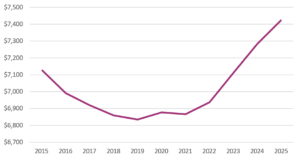
Source: Calculations based on Western Power’s AA5 Regulatory Revenue Model, and Energy and Customer Number Forecast Report.
This does not in itself mean that the level of investment being proposed by Western Power is inappropriate or unnecessary. What it does indicate though is the long term challenges that there will be for ensuring electricity affordability if the RAB continues to grow and so necessitates close scrutiny.
Where possible, Western Power should give consideration to writing down asset values. As a direct contributor to network costs for consumers, reducing the value of the regulated asset base would result in savings for the network component of consumer’s bills. The Australian Competition and Consumer Commission has stated that:
The value of network asset bases is a direct determinant of the amounts paid by electricity users for network charges, and hence directly affects electricity affordability. A RAB writedown would, all else being equal, lead to reduced network costs.8
This position was also articulated in the Finkel Review, which found that writing down asset values “would have the effect of lowering prices for consumers, and reducing the size of the regulated asset base without increasing the risk profile of the investment.”9
Recommendation: Continued growth in the Regulated Asset Base needs to be closely scrutinised and avoided where possible, with asset write-downs considered.
Calculating the Cost of Debt
WACOSS notes that Western Power is recommending the ERA depart from its current approach to estimating the return on debt, which involves utilising a hybrid trailing average method. Western Power proposes instead that a full trailing average approach should be adopted that applies to the entire cost of debt, with the risk free rate not fixed for the duration of the regulatory period.10
WACOSS does not consider, however, that sufficient justification for departing from the ERA’s current approach has been presented in Western Power’s submission. As stated in the Consumer Reference Group submission for the ERA’s 2022 Gas Rate of Return Instrument Review,
The hybrid trailing average recognises, that in practice, typically not all debt is refinanced on a single day while also recognising the role of current risk free interest rates in the period immediately before the regulatory decision for the particular regulatory period in providing efficient investment signals and satisfying the NPV=0 condition.11
WACOSS further notes that the approach Western Power favours would, according to the ERA’s Issues Paper, increase debt costs by approximately $383 million over the AA5 period. It is not apparent that such a change would be in the long term interests of consumers and instead may overstate the cost of debt. WACOSS considers that continuing to incorporate the hybrid trailing average into the ERA’s approach to estimating return on debt remains appropriate.
Recommendation: Maintain the ERA’s current approach to calculating the cost of debt.
Term for the Risk Free Rate for Equity
WACOSS notes that Western Power is recommending an increase in the term of the risk free rate for equity to ten years, up from a term of five years. WACOSS does not consider that such a change is justified by the evidence provided. As stated in the Consumer Reference Group submission for the ERA’s 2022 Gas Rate of Return Instrument Review,
With a five-year regulatory cycle, prices are reset every five years and the relevant return on equity is the return on equity at the start of each regulatory period. The risk free rate and expected market risk premium at the time should reflect prevailing conditions expected over the five-year time frame.12
Western Power’s recommendation to increase the term of the risk free rate to ten years from five, would increase the revenue for equity costs by approximately $215 million over the AA5 period, as outlined in the ERA’s Issues Paper. WACOSS considers that the ERA’s current approach in using a five-year term for the risk free rate remains appropriate and in the long term interests of consumers.
Recommendation: Maintain the ERA’s current approach to the term of the risk free rate for equity.
Service Standards and Reliability
WACOSS considers that it may be appropriate that reporting measures focussing on reliability performance in specific areas of the network where reliability is below or tracking below the benchmark be incorporated into the access arrangement. In particular, greater disaggregation of the current locational categories currently reported on could improve visibility of reliability across sections of the network and allow for greater transparency around proposed investment where it is accompanied by a sufficient level of granularity.
This should not necessarily mean, however, that service standards for the network are strengthened and those standards must be considered in connection with what the impacts will be on the electricity bills of residential consumers. To justify increasing service standard performance, it would need to be demonstrated that the resulting investment would create a proportionate level of benefit for consumers. Consideration should also be had as to who is best placed to bear the costs and risks of network investment, and whether network investment is even the relevant response.
Service standards are a critical driver of costs, with stronger service standards incentivising utilities to lift performance. If not set appropriately, requiring higher service standard performance can lift system reliability above the point where customers are willing to pay for improvements in service.
As such, it is critical that the question of the trade-off between service quality and price is considered in terms of consumers’ willingness to pay for service quality levels, and the hardship experienced by some consumers connected to the network.
It is clear from the consumer engagement undertaken by Western Power that most residential consumers did not support increasing network reliability if it resulted in an increase in their bills.13 While it is important to note that this consumer engagement occurred prior to the Christmas 2021 outages, this should not result in the stated preferences of consumers being disregarded. It may indicate, however, that further consumer engagement on this issue is required.
If service standards are not set based on consumer preferences, they risk increasing network investment beyond what is prudent and economically efficient. Methods such as deliberative forums should be engaged in to fully explore and understand what the preferences of consumers are in terms of service reliability and prices. Such forums better enable consumers to be appropriately equipped to consider the consequences and outcomes of the trade-off between service quality and price in a way that instruments such as surveys are unable to achieve.
Strengthening service standards to prevent outages from occurring could have significant unintended consequences if it leads to higher electricity prices and disconnections due to unaffordable bills. It would not be a desirable outcome should service standards be raised to the point where it leads to more consumers disconnecting due to financial hardship or being forced to ration their electricity use to the point where it effects their health and wellbeing.
Recommendation: Service standards should not exceed consumers’ willingness to pay for service quality levels.
Tariff Structure Statement
WACOSS is concerned that Western Power’s proposed tariff structure is inefficient, inequitable and not cost-reflective. It is not at all apparent that the impact that their proposal will have on consumers has been adequately considered, with insufficient modelling and information provided to assist consumers understand the impact the changes will have on their bills.
Fixed Charges
In particular, WACOSS is concerned by Western Power’s proposal to increase the fixed charge component of the reference tariffs. As discussed earlier, data indicates that low-income households are overrepresented amongst low-energy users, which means a higher fixed charge is a regressive measure that penalises low energy using customers and could result in low-income households subsidising higher income households.
Western Power appears to consider that the principle of minimising distortions to efficient usage decisions necessitates that they recover residual costs through higher fixed charges. This is not, however, the case. In fact, in the same Australian Energy Market Commission (AEMC) Rule Determination that Western Power quotes from in relation to fixed charges, the AEMC makes clear that the principle of minimising distortions to efficient usage decisions “does not require that residual costs are recovered though increases to fixed charges.”14
Further, Western Power appears to contend that the Code necessitates this action. It is important to note, however, that Section 7.3F of the Code specifically states that
The structure of reference tariffs must, so far as is consistent with the Code objective, accommodate the reasonable requirements of users collectively and end-use customers collectively.
The Code provides the following example to illustrate what this section means:
Customers may prefer more of the average cost of service provision to be recovered using tariff components that vary with usage or demand than might otherwise be the case under section 7.6.
It would seem clear from this example that the Code is not necessitating that residual costs are recovered through fixed charges where that does not accommodate the reasonable requirements of end-use consumers.
In recognition that increasing the fixed charge component does not “accommodate the reasonable requirements, or preferences, of users and end customers,” Western Power proposes to transition
away from variable charges gradually. WACOSS contends, however, that this cannot be considered to provide in any meaningful way a balance between consumer preferences and what Western Power considers to be efficient. Simply transitioning to a tariff structure that is contrary to consumer preferences and interests slowly does not ameliorate the fact that what would be implemented is a tariff structure that is contrary to consumer preferences and interests.
Higher fixed charges are also not appropriately cost-reflective as they do not reflect the true costs of supply nor what is creating those costs. If tariffs were genuinely cost-reflective, they would send effective price signals to consumers creating the greatest costs for the network and, as a result, decrease the cost burden for other consumers. The undesirability of higher fixed charges has been articulated by the ACCC, which stated
while flat tariffs with a high fixed component may better match the cost profile of network businesses, they are not cost reflective and may even result in worse incentives on customers. By reducing the variable charge, customers have less incentive to manage their overall consumption (including at peak times), which may lead to overall increases in future network costs. These tariffs also fail to deal with cross-subsidies in favour of customers who use a larger proportion of electricity at peak times (and may in fact worsen the cross-subsidy where high peak period users are also high overall users of electricity).15
A very prominent cross-subsidy that higher fixed charges exacerbates is in relation to air conditioning (A/C) systems, as those with A/C systems are being subsidised by those without. Further, that cross-subsidy grows with the size of the A/C system, meaning that those with small systems are also subsiding those with larger systems. The Productivity Commission has previously estimated the size of the existing subsidy for a household with A/C to be $350 a year from those without it.16 The more that network charges are fixed, the greater the subsidy is for owners of A/C as the component of the network charges that reflect usage is reduced.
Further, an increase in fixed charges undermines the capacity and incentive for consumers to manage their bills by reducing their electricity use. For a consumer in financial hardship, their options for managing their energy bills are limited. Aside from redirecting money away from other essential items, like rent and food, or taking on some form of debt, lowering their electricity usage can be the only lever available to them.
Increasing fixed charges is a simplistic response to the challenges that high numbers of households installing solar PV, and the resulting reduction in their consumption, pose for networks. It is a socialising of the costs of upgrading the network to accommodate DER and the recovery of the otherwise lost revenue. This is clearly inequitable for consumers without DER, including low-income households that cannot afford it and those who are unable to access it, such as renters.
Recommendation: The fixed charge component of the reference tariffs should not be increased.
Accommodating DER
WACOSS notes that Western Power is proposing four new solar sponge-style super-off peak time of use (ToU) tariffs. These tariffs are a welcome step towards better accommodating DER and reshaping grid demand. While the impacts of these tariffs will be mediated by the retailer and how they pass through any benefits to consumers, WACOSS considers that it would be advantageous for analysis to be undertaken as to the expected outcomes these tariffs may have in terms of network costs.
WACOSS also considers that analysis would be warranted in regards to the potential impact of these new tariffs for consumers experiencing vulnerabilities. For the 2021-2026 Victorian Electricity Distributors Regulatory Proposals, the Distribution Network Service Providers commissioned analysis from ACIL Allen into the potential impacts that shifting to a ToU tariff could have on those that were identified as vulnerable customers.
Though this analysis was limited in scope and sample size, with the bill impacts examined for only 293 vulnerable customers, this research found that around 27 per cent of those vulnerable customers would be negatively impacted by the shift to a ToU tariff.17 Under this modelling, 41 per cent of the vulnerable customers identified saw no impact to their bills, with the remainder seeing a reduction in their bills. What this high level analysis demonstrates is the need to better understand what the consequences of introducing a new tariff would be for different customer groups.
It is critical that analysis of a similar nature is undertaken in relation to Western Power’s proposal. From the information that Western Power have submitted, it is not at all apparent that they have undertaken any detailed analysis or had serious consideration as to what the impacts of their proposed tariff structure statement will have on consumers with particular vulnerabilities. Though these tariffs may not be targeted at consumers with vulnerabilities, there is no reason to consider that a person who is on such a tariff could not be vulnerable or later develop vulnerabilities, be they related to financial circumstances or health conditions, as just two examples. This analysis should be sufficiently granular so that it is possible to develop programs or ensure tariff options are available that do not increase hardship for vulnerable customers.
It is integral to understand whether these tariffs could lead to unintended and unacceptable consequences, such as a household restricting their energy consumption to the detriment of their health and wellbeing. WACOSS contends that analysis of this nature should always form part of the documentation that Western Power puts forward for consideration when they are seeking to make changes to tariffs.
Recommendation: Analysis is required as to the potential impacts of the new super-off peak time of use tariffs on different household types.
Western Power makes the claim that these new tariffs represent a “customer-led, demand-side response to solar PV”, as opposed to the changes being advanced in the National Energy Market (NEM), which they describe as “using export prices to discourage exports from small-scale solar PV.” WACOSS considers this to be either a misunderstanding or a mischaracterisation of the rule change and subsequent processes that are happening in the NEM, and that adopting a similar approach should not be dismissed so readily.
The package of changes as set out by the AEMC, which includes enabling two-way pricing, is designed to allow for more DER to be integrated into the grid rather than discouraging it. The reforms are in response to the rule change proposal put forward by the Australian Council of Social Service and the Total Environment Centre to specifically address the challenges of fairness and equity in the uptake of DER, while actively enabling the acceleration of rooftop solar for households.18
These changes require networks to offer a free-of-charge basic export service, set at a level where export services can be provided without requiring additional investment, and prevents them applying zero export limits to customers. At the same time, it enables consumers who want to export above that level to do so, but ensures that those who are benefiting the most from any necessary upgrades to the grid are contributing more to covering the costs of those upgrades.
As the AEMC states,
implementation of price signals allocates the risk of excessive demand for network services, which could lead to inefficient network expenditure, to the customers making those demands. Non-DER households (who, in the absence of export pricing, contribute to DER- related costs) do not have the ability to take actions to manage the risk of excessive demand for network export services. DER owners will have an incentive to manage the risk because they will seek to minimise bill impacts.19
It is worth noting that consumer research conducted by Newgate Research on behalf of Energy Consumers Australia found that 69 per cent of Australian consumers felt positive about these reforms, with only 6 per cent of consumers viewing them negatively. Further, the support for the reforms was highest amongst those households with large bills at 78 per cent, and those who were considering purchasing solar panels at 77 per cent.20
WACOSS contends that the changes being progressed in the NEM provide a greater ‘customer-led, demand-side response to solar PV’ than super off-peak ToU tariffs alone enable, as well as promoting a much more significant level of affordability and fairness. Smearing the costs associated with DER upgrades across the customer base, with no consideration as to who is causing the need for those upgrades to take place or who is benefitting from them, places an inequitable cost burden on households without DER, which includes many on low incomes. A fair and efficient allocation of costs should see those costs borne by those who are benefiting the most from that investment.
Recommendation: Two-way pricing options should be considered for households with solar PV to ensure greater affordability and fairness, while enabling higher levels of DER integration.
Future of RT1/A1 Tariff
WACOSS observes that though there is no clear statement in Western Power’s access arrangement proposal that there is an intention to phase out the RT1 – A1 anytime energy tariff for residential customers, that there is a note in the Energy and Customer Numbers Forecast Report that all RT1 NMIs are assumed to have been reclassified to the three-part ToU RT17 tariff by 2025. It should be noted that the Tariff Structure Statement Technical Summary indicates that the RT17 will in fact be closed to new entrants under the AA5 proposal. As the principal tariff for residential consumers, clarity is needed as to what the intentions are for the future of the A1 service and whether the intention is that no flat rate retail tariff will be available to residential consumers from 2025.
As stated above in relation to the super off-peak tariffs, it is critical that any changes to tariffs, particularly of this magnitude, are only conducted following thorough examination of the impacts that this would have on consumers living on low incomes or who are experiencing other forms of vulnerability. Any such change should be explored through a series of pilots and trials first so that a proper understanding of those impacts can be formed and appropriately addressed, with any necessary protections introduced for vulnerable consumers, before there is any move to full implementation.
For consumers who have limited ability to shift or reduce their electricity consumption and may be worse off under a ToU tariff, flat tariffs can act as a critical safety net. As a result, retaining a flat tariff option has been considered appropriate in a number of other Australian jurisdictions. Further, WACOSS contends that in order to ensure that low income and vulnerable households are not disadvantaged further by major tariff reform, it must be progressed in a coordinated manner with Synergy and the State Government to include reform of electricity concessions. In particular, it should involve shifting towards a percentage-based primary concession. Percentage-based concessions are calculated in proportion to usage so they ensure eligible households with higher energy needs receive more assistance. This approach also better supports individual households to cope with fluctuations in their energy consumption over time due to changing needs and seasonal variations.
Recommendation: Clarity is needed as to the proposed future of the RT1 Tariff.
Proposed Price Path
WACOSS welcomes the intention of Western Power to ensure affordable price outcomes for customers by holding nominal price increases for the average network bill to below inflation. Western Power proposes a cap on tariff increases of 5.7 per cent in year two, and of 2 per cent in each subsequent year. Though the tariff structure statement does not include a forecast of weighted average price changes, WACOSS notes the statement by Western Power in the Access Arrangement Information document that “[i]f passed on to regulated retail customers, the proposal would result in a one-off increase of $25 in 2023/24 to the retail bill of an average consumption customer, then flat for the remainder of AA5”.
WACOSS considers that a smoother price path over the AA5 period would be preferable to a one-off increase in year two. It is typically easier for consumers to respond to price movements that are introduced gradually. Should the price increase be passed through, it risks creating a price shock for the consumer. For a low-income household, this can increase the challenges of managing their already stretched income by needing to accommodate this step change.
Recommendation: A smoother price path over the AA5 period should be applied.
Read and download a PDF version of this Submission to the Economic Regulation Authority on Western Power’s fifth access arrangement review.
If you would like to discuss this submission further, please contact WACOSS Senior Policy Officer Graham Hansen at [email protected] or 08 6381 5300.
References
1 Economic Regulation Authority (2021) Switched On: Energy Consumers Guide.
2 L Nicholls, H McCann, Y Strengers K & Bosomworth (2017) Heatwaves, homes and health: Why household vulnerability to extreme heat is an electricity policy issue.
3 ABS (2013) 4670.0 – Household Energy Consumption Survey: Summary of Results.
4 ACOSS and the Brotherhood of St Laurence (2018) Energy Stressed in Australia
5 Ibid.
6 Ami Seivwright and Paul Flatau (2019) Insights into hardship and disadvantage in Perth, Western Australia: The 100 Families WA Baseline Report. The 100 Families WA project.
7 Analysis only extends to 2025 as that is the last year included in Western Power’s Energy and Customer Number Forecast Report.
8 Australian Competition and Consumer Commission (2019) Restoring electricity affordability and Australia’s competitive advantage.
9 Dr Alan Finkel (2017) Independent Review into the Future Security of the National Electricity Market.
10 Western Power (2022) Considerations for the regulatory rate of return allowance.
11 Consumer Reference Group (2022) Submission on the ERA 2022 Rate of Return Instrument Review Discussion Paper of December 2021
12 Ibid.
13 Western Power (2022) Community & Customer Engagement Program Report.
14 Australian Energy Market Commission (2014) Rule Determination: National Electricity Amendment (Distribution Network Pricing Arrangements) Rule.
15 Australian Competition and Consumer Commission (2019).
16 Productivity Commission (2013) Electricity Network Regulatory Frameworks Vol 1.
17 Jemena Electricity Networks (2020) Tariff structure statement – Explanatory document for 1 July 2021 to 30 June 2026.
18 Australian Council of Social Service and the Total Environment Centre (2020) More Sun for Everyone: Distributed Energy Resources Rule Change.
19 Australian Energy Market Commission (2021) Access, pricing and incentive arrangements for distributed energy resources, Rule determination.
20 Newgate Research (2021) Community Attitudes to Rooftop Solar and the AEMC’s Proposed Reforms.

